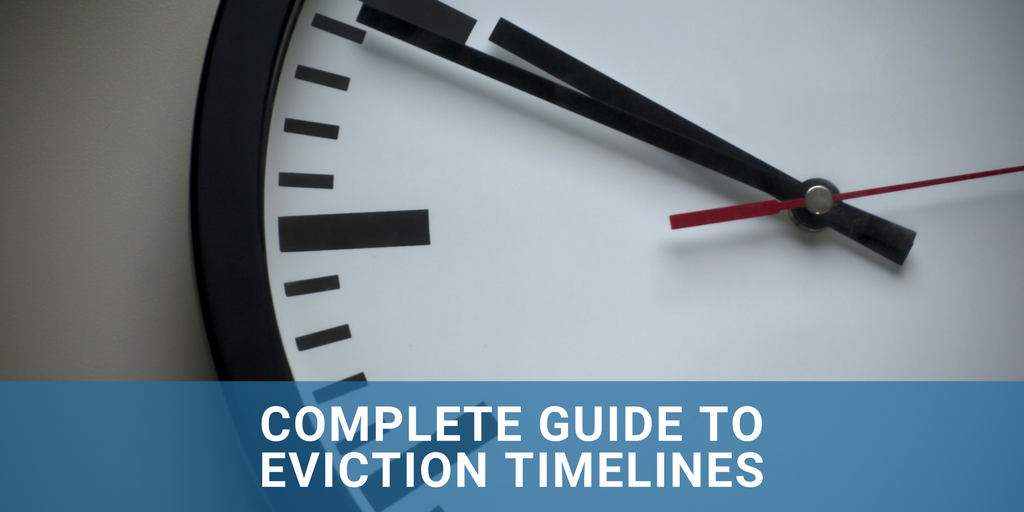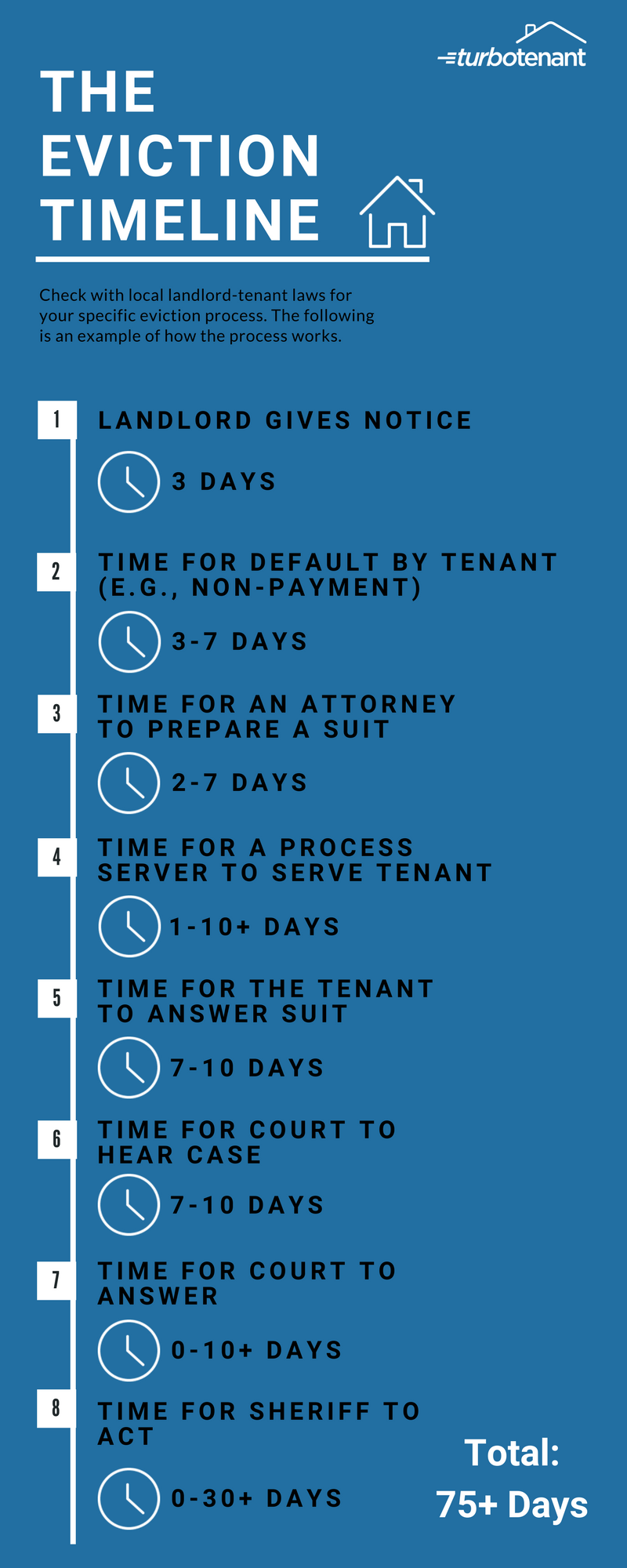One of the worst nightmares for landlords is going through the eviction process. For those who are new to landlording, an eviction might not seem like that big of a deal. However, evictions are not a simple process. Not only are there a huge array of steps to the eviction process, the time frame for successfully evicting someone is longer than most people think.
If you are facing an eviction and you are curious about how the process works, what the eviction timeline is, and what you should expect ahead, read on to learn more in our complete guide to eviction timelines.
Quick Overview Of An Eviction
The exact time frame for an eviction will vary depending on the specific regulations of the area you live in. Before you start an eviction process, it is always important to ensure you understand your local landlord-tenant laws. When in doubt, consult with an attorney. Due to the heated nature of evictions, you need to be 100 percent confident you are doing everything within the confines of the law in case the tenant takes action against you.
The quick overview of what an eviction timeline looks like is as follows:
- Landlord gives notice: 3 days
- Time for default by tenant (e.g., non-payment): 3 – 7 days
- Time for landlord to hire an attorney and for the attorney to prepare a suit: 2 – 7 days
- Time for a process server to serve tenant – 1 -10+ days
- Time for the tenant to answer suit: 7 – 10 days
- Time for court to hear case: 7 – 10 days
- Time for court to answer: 0 – 10+ days
- Time for sheriff to act: 1 – 30+ days
Total Time:
Roughly 75+ days
Digging Deeper Into The Eviction Process
It is important to note that the specific timeline and process for eviction will vary by state. The following is an example of how the eviction process works in some locations. Be sure to consult with a local attorney before proceeding with an eviction.
Step 1: Landlord gives notice
The first step in the eviction process is for the landlord to give the tenant notice of eviction. This notice should be mailed to the tenant. Notice is considered to be given three days after the postmark. The notice should include the reason why you’re pursuing eviction, such as failure to pay rent, and what actions should be taken by the tenant to remediate the situation. This is often referred to as a pay or vacate notice and usually, requires an action is taken within three business days.
Step 2: Time for default by tenant
During the next step of the eviction process, the tenant will have time to either remedy the situation or to default through non-payment. As the landlord, you have to wait until the applicable number of days has passed before moving on to the next step. The above time frame of three days to vacate or pay is a fairly common standard in the U.S., but it could vary anywhere from 24 hours to seven days.
Step 3: Time for an attorney to prepare a suit
Once the appropriate time has passed and if the tenant has defaulted through non-payment, you will want to hire an attorney to proceed. The attorney will then need to prepare a suit, which will take at best two to seven days but could take significantly longer depending on the attorney hired.
Step 4: Time for a process server to serve tenant
After your attorney has prepared a suit, you will need to serve the tenant with the suit. This is usually done by a process server. This part of the process could happen immediately or could take a significant number of days. This will depend entirely on whether or not the tenant is easy to reach or is working to avoid the process server. Estimated time for this step is one to ten plus days.
Step 5: Time for the tenant to answer suit
After the tenant has been served, you will have to wait on them to answer the suit. Usually, the time frame in which they need to answer is between seven to ten days. Speak to your attorney about the specific time frame for your situation.
Step 6: Time for court to hear case
Once the tenant has answered the suit, the case will be heard in court. This stage of the process can take anywhere from a week to ten days, depending on how fast your court system operates.
Step 7: Time for court to answer
After the case has been brought before the court, an answer will be given. However, contrary to what one might believe, the answer does not have to be given immediately. Sometimes more time will pass before the court gives a final decision. This part of the process will take anywhere from zero to ten days on average.
Step 8: Time for sheriff to act
The final step in the eviction process will fall to the local sheriff. If the court rules in favor of the landlord, then a sheriff will be responsible for evicting the tenant. Similar to many steps in the eviction process, the length of time it will take a sheriff to actually evict your tenant will vary greatly. Sometimes, sheriffs will handle the issues immediately, and other times it will take them a long period of time. The estimated time frame for this step is anywhere from one to thirty days.
The Takeaway:
Depending on where you live, some of these steps may not exist as part of your process. In other cases, there may actually be additional steps for the eviction process. For example, in Missoula, Montana, mediation is required prior to a court action. If mediation doesn’t resolve the issue, then it can go on to court. In this situation, the process would actually be longer than the above-mentioned steps. It also should be noted that depending upon courts and states time frames may be calendar or business days.
Regardless of where you live, the process of eviction is never simple. It is usually extremely time consuming and can cost you copiously in lost rent revenue.
Protect Yourself With Tenant Screening
The goal of every landlord should be to avoid evictions. It is far better to take your time with tenant screening and to ensure you have a reliable tenant than to fill a vacancy quickly with a trouble tenant. The eviction process will cost you more in lost rent revenue than simply letting time pass before filling it with the right tenant.
Protect yourself against evictions by first marketing your property effectively so you have a larger pool of tenants to choose from. Then stick to screening your tenants thoroughly. While there are never any guarantees when it comes to choosing a tenant, the better your tenant screening process is the greater chance you have of finding a responsible tenant. Look at their credit score, criminal background, and their eviction history. Don’t waver on your criteria and wait until you find the right tenant.
DISCLAIMER: TurboTenant, Inc. does not provide legal advice. This material has been prepared for informational purposes only. All users are advised to check all applicable local, state and federal laws and consult legal counsel should questions arise.








